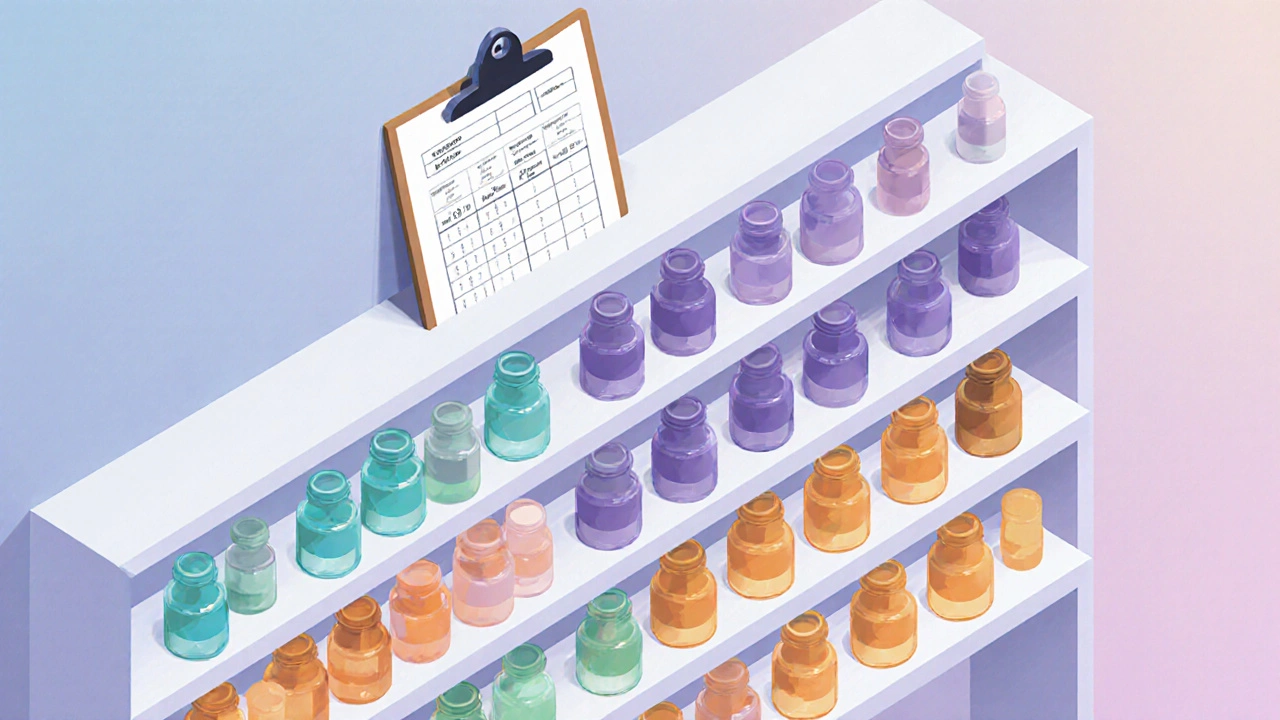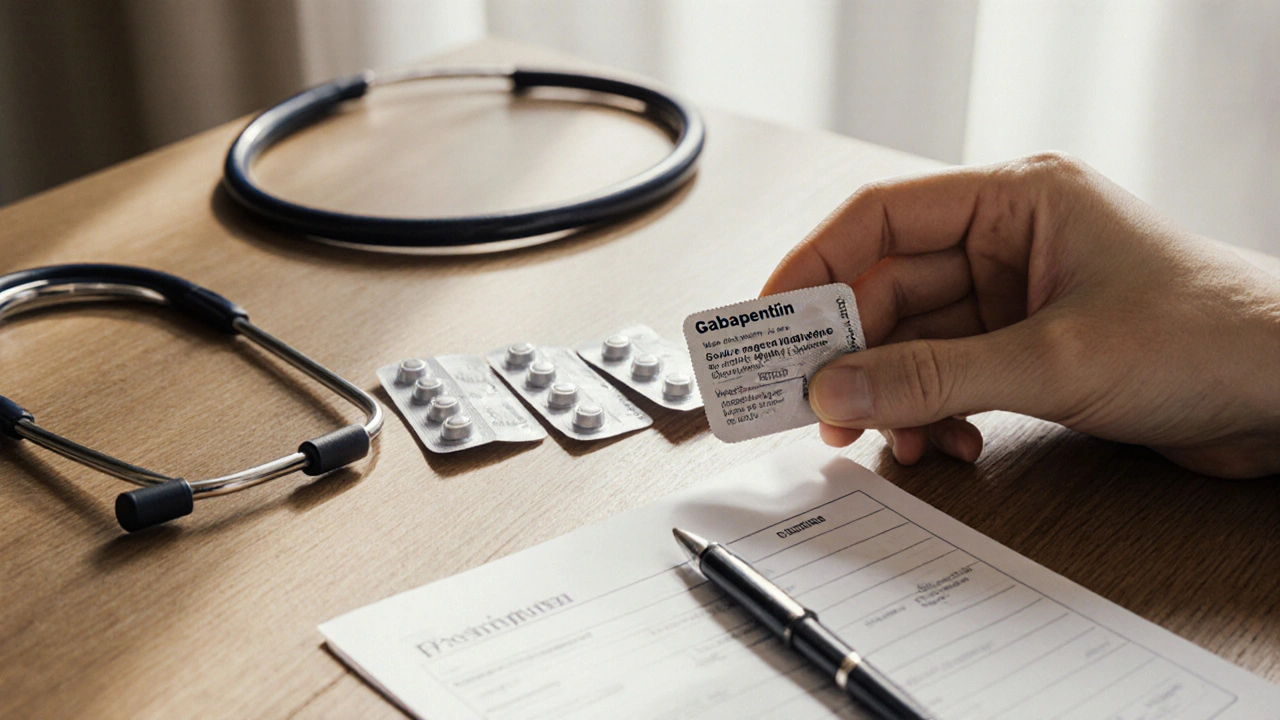Gabapentin Alternative Selector
Find Your Best Fit
Answer a few questions to see which gabapentin alternative might be most suitable for your specific situation.
Recommended Options
Top Match
When doctors prescribe medication for nerve pain or seizures, Gabapentin alternatives quickly become a hot topic. Patients want to know whether the brand‑name Neurontin (gabapentin) is the best fit, or if another drug might work faster, cause fewer side effects, or cost less. This guide walks you through the most common substitutes, the factors you should weigh, and a side‑by‑side table that makes the decision crystal clear.
Key Takeaways
- Neurontin is effective for neuropathic pain and partial seizures, but it can take 1‑2 weeks to feel relief.
- Pregabalin (“Lyrica”) works faster and often costs more, while duloxetine and amitriptyline are cheap oral options that also treat depression.
- Side‑effect profiles differ: gabapentin and pregabalin cause dizziness, whereas tricyclic antidepressants (amitriptyline, nortriptyline) can cause dry mouth and constipation.
- Kidney function, age, and drug interactions are the top three medical criteria for choosing an alternative.
- UK NHS pricing varies widely; generic gabapentin is usually the cheapest, followed by amitriptyline, while pregabalin remains premium.
What Is Neurontin (Gabapentin)?
Neurontin is the trade name for gabapentin, an anticonvulsant originally approved to treat epilepsy. Over the years it earned a second‑line indication for peripheral neuropathy, post‑herpetic neuralgia, and fibromyalgia‑related pain. The drug mimics the neurotransmitter GABA but doesn’t bind to GABA receptors; instead, it modulates calcium channels, dampening the release of excitatory neurotransmitters.
Typical adult dosing starts at 300mg once daily, titrated up to 900-1800mg in three divided doses for pain. For seizures, doctors may go as high as 3600mg daily, split into three doses. The medication is eliminated unchanged by the kidneys, so renal function strongly influences the safe dose.
Why Look at Alternatives?
Even though Neurontin is widely prescribed, it isn’t perfect. Some patients never achieve adequate pain control, while others struggle with drowsiness, edema, or weight gain. Cost can also be a barrier; although generic gabapentin is inexpensive, brand‑name formulations or extended‑release versions can be pricier. Finally, certain comorbidities-like severe depression or chronic migraine-might make a drug that addresses multiple symptoms more attractive.

Criteria for Comparing Medications
- Indication fit: Does the drug treat neuropathic pain, seizures, or both?
- Onset of pain relief: How quickly does a patient feel benefit?
- Dosing convenience: Once‑daily versus multiple doses.
- Side‑effect burden: Sedation, dizziness, weight gain, anticholinergic effects, etc.
- Renal & hepatic safety: Important for older adults.
- Cost (UK NHS price): Generic versus brand, daily cost in GBP.
Comparison Table
| Medication | Primary Indications | Typical Dose Range (adult) | Onset of Pain Relief | Common Side Effects | Renal Considerations | UK NHS Daily Cost (approx.) |
|---|---|---|---|---|---|---|
| Neurontin (gabapentin) | Neuropathic pain, partial seizures | 300‑1800mg/day (pain)-3600mg/day (seizure) | 7‑14 days | Dizziness, edema, weight gain | Dose‑adjust if CrCl<60ml/min | £0.10‑£0.30 per tablet |
| Pregabalin (Lyrica) | Neuropathic pain, fibromyalgia, seizures, generalized anxiety | 150‑600mg/day (pain)-600mg/day (seizure) | 3‑5 days | Dizziness, somnolence, dry mouth | Adjust if CrCl<30ml/min | £0.60‑£1.20 per capsule |
| Duloxetine | Diabetic neuropathy, major depressive disorder, generalized anxiety | 30‑60mg/day | 1‑2 weeks | Nausea, dry mouth, insomnia | Use with caution in severe renal impairment | £0.20‑£0.35 per tablet |
| Amitriptyline | Neuropathic pain, chronic migraine prophylaxis, depression | 10‑75mg/day (pain)-25‑150mg/day (depression) | 2‑4 weeks | Dry mouth, constipation, weight gain, cardiac conduction delay | Safe in renal failure; monitor heart | £0.02‑£0.05 per tablet |
| Carbamazepine | Trigeminal neuralgia, focal seizures | 200‑1200mg/day | 4‑7 days | Dizziness, hyponatremia, rash | Metabolized hepatically; watch liver enzymes | £0.08‑£0.15 per tablet |
Deep Dive Into Each Alternative
Pregabalin (Lyrica)
Pregabalin is a gabapentinoid like gabapentin but with higher binding affinity for the α₂‑δ subunit of voltage‑gated calcium channels. Because of that stronger binding, patients often notice pain relief within a few days, making it a go‑to for acute flare‑ups. The downside? It’s priced higher and requires dose adjustment for moderate‑to‑severe renal impairment. It also carries a Schedule5 classification in the UK, so prescribing doctors need to monitor for misuse.
Duloxetine (Cymbalta)
Duloxetine is a serotonin‑norepinephrine reuptake inhibitor (SNRI) that tackles pain by enhancing descending inhibitory pathways in the spinal cord. It’s especially useful when neuropathic pain coexists with depression or anxiety. Common complaints include nausea and a mild increase in blood pressure, so baseline vitals are advisable before starting therapy.
Amitriptyline
Amitriptyline belongs to the tricyclic antidepressant (TCA) class and has strong antihistamine and anticholinergic actions. Low‑dose regimens (10‑25mg at bedtime) often control neuropathic pain with the added bonus of improving sleep. However, TCAs can prolong the QT interval and should be avoided in patients with known cardiac arrhythmias.
Carbamazepine
Carbamazepine is a sodium‑channel blocker primarily used for trigeminal neuralgia and focal seizures. While it’s not first‑line for typical peripheral neuropathy, it shines in facial nerve pain where other agents fail. The major concerns are hematologic side effects (e.g., agranulocytosis) and drug‑drug interactions via CYP3A4 induction.

How to Choose the Right Option for You
Think of medication selection as a checklist rather than a gamble. Start with the condition you’re treating, then apply the criteria from earlier. Here’s a quick decision tree you can follow:
- If you have normal kidney function and need a cheap, well‑tolerated drug, Neurontin is a solid starter.
- If rapid pain control is essential (e.g., post‑surgical nerve injury), jump to Pregabalin.
- If you also suffer from depression, anxiety, or chronic low back pain, consider Duloxetine for its dual action.
- If you’re over 65, have mild renal impairment, and want a once‑daily nighttime pill, Amitriptyline at low dose works well.
- If facial nerve pain (trigeminal neuralgia) dominates the picture, Carbamazepine should be your first try.
Always discuss these options with your GP or neurologist; blood tests for liver/kidney function and ECGs for cardiac safety may be required before initiating therapy.
Practical Tips & Common Pitfalls
- Start low, go slow: Titrate gabapentinoids by 300mg every 3‑5 days to limit dizziness.
- Watch for weight gain: Gabapentin and pregabalin can cause fluid retention; a simple daily weigh‑in helps catch it early.
- Don’t mix with alcohol: All these drugs increase CNS depression, raising fall risk.
- Check for drug interactions: Carbamazepine induces many enzymes, lowering levels of oral contraceptives and warfarin.
- Plan for tapering: Sudden stop of gabapentinoids can trigger seizures; gradually reduce over 1‑2 weeks.
Frequently Asked Questions
Is gabapentin more effective than pregabalin for diabetic neuropathy?
Clinical trials show pregabalin reaches pain relief about 3‑5 days faster, but both achieve similar long‑term efficacy. If speed matters, pregabalin wins; if cost is the priority, gabapentin is preferable.
Can I take gabapentin and duloxetine together?
Yes, many physicians combine them to tackle pain from two mechanisms. Start duloxetine at 30mg daily while keeping gabapentin at a low dose, then monitor for additive dizziness or serotonin syndrome-rare but possible.
What’s the biggest side‑effect difference between gabapentin and amitriptyline?
Gabapentin mainly causes swelling and mild sedation, whereas amitriptyline brings anticholinergic effects like dry mouth, constipation, and potential heart rhythm changes.
Is pregabalin covered by the NHS for neuropathic pain?
Pregabalin is prescribed on the NHS for specific conditions (fibromyalgia, diabetic neuropathy) but usually requires a specialist’s approval because of its higher cost.
How long should I stay on gabapentin before deciding it’s not working?
Give the drug at a therapeutic dose for at least 2‑3 weeks. If pain reduction is under 30% after that period, discuss alternatives with your clinician.
Next Steps
Grab a notebook, list your personal priorities-speed, cost, side‑effect tolerance, existing health conditions-and use the table above to narrow down two candidates. Schedule a brief appointment with your GP to review kidney function and potential drug interactions. With a clear plan, you’ll avoid the trial‑and‑error nightmare and land on the medication that fits your lifestyle.

Jenn Zee
October 13, 2025 AT 15:56It is a profound disappointment that the medical community continues to glorify gabapentin without a rigorous examination of its pharmacodynamic shortcomings. The marketing hype cloaks the modest efficacy of Neurontin in a veneer of pseudo‑science that is frankly unacceptable for discerning clinicians. One must first acknowledge that gabapentin’s mechanism of action, a vague modulation of voltage‑gated calcium channels, lacks the specificity that modern therapeutics demand. Moreover, the titration schedule, often extending over weeks, betrays an inherent laziness in drug development. In contrast, alternatives such as pregabalin demonstrate a more rapid onset of analgesia, a fact supported by multiple blinded trials. The side‑effect profile of gabapentin, replete with dizziness, edema, and insidious weight gain, is not a trivial inconvenience but a clinically significant burden. Renal excretion necessitates dose adjustments that many practitioners overlook, thereby exposing patients to potential toxicity. Cost considerations, while seemingly favorable for generic gabapentin, obscure the downstream expense of managing adverse events. The comparative table presented in the guide, albeit comprehensive, fails to critique the ethical dimensions of prescribing a drug with such a marginal benefit‑risk ratio. Furthermore, the guide neglects to address the off‑label abuse potential that has been documented in vulnerable populations. It is incumbent upon us, as stewards of patient welfare, to demand higher standards of evidence before endorsing gabapentin as a first‑line agent. The alternative agents, particularly duloxetine, offer dual benefits for comorbid depression, thereby providing a more holistic therapeutic approach. One must also consider hepatic safety; while gabapentin is renally cleared, its sibling pregabalin shares similar pathways but exhibits a more predictable pharmacokinetic profile. The narrative that “low cost equals good choice” is a simplistic fallacy that belies the complex economics of healthcare. In sum, the guide’s portrayal of gabapentin as a neutral option is a disservice to both clinicians and patients. A more critical appraisal would elevate patient safety above pharmaceutical convenience.
Steph Hooton
October 15, 2025 AT 09:36Thank you for the thorough compilation; the table provides a useful snapshot of the therapeutic landscape. However, I would like to suggest a minor recomendation regarding the inclusion of dosage adjustment guidelines for patients with impaired renal function. It would enhance the clarity of the guide for clinicians who are navigating complex dosing regimens. Additionally, a brief discussion on the potential for drug‑drug interactions with common antihypertensives could be beneficial. Overall, the effort is commendable and will undoubtedly aid many readers.
Judson Voss
October 17, 2025 AT 03:16This guide reeks of bias toward cheaper drugs and neglects the superior efficacy of newer agents.
Jessica Di Giannantonio
October 18, 2025 AT 20:56The journey through neuropathic pain treatment can feel like wandering in a fog, but this guide offers a lantern of hope. I find solace in the detailed comparison, especially the emphasis on side‑effect profiles that often go unnoticed. Though I rarely speak up, I must applaud the clarity and depth provided here. May more patients find the relief they deserve.
RUCHIKA SHAH
October 20, 2025 AT 14:36Gabapentin works for some people. It can cause drowsiness. If kidney function is low you may need a lower dose. Pregabalin may act faster but costs more. Talk to your doctor about options
Justin Channell
October 22, 2025 AT 08:16Great guide 👍 I love how it lays out the pros and cons 😃 makes it easy to see what fits your needs 💊
Basu Dev
October 24, 2025 AT 01:56When evaluating gabapentin versus its alternatives, it is essential to adopt a systematic approach that accounts for pharmacokinetics, patient comorbidities, and socioeconomic factors. First, consider the absorption characteristics; gabapentin exhibits saturable absorption, which can limit its bioavailability at higher doses, whereas pregabalin maintains linear absorption across its dosing range. Second, renal clearance must be scrutinized; for patients with moderate to severe renal impairment, dose reduction of gabapentin is mandatory, while alternatives such as duloxetine have hepatic metabolism and may be preferable in certain scenarios. Third, the side‑effect spectrum differs markedly: gabapentin is associated with peripheral edema and weight gain, whereas tricyclic antidepressants bring anticholinergic burden that can be undesirable for older adults. Fourth, cost analysis should extend beyond the price of the medication itself to incorporate the financial impact of managing adverse events, which can offset any savings from a lower drug price. Finally, patient preference regarding dosing frequency plays a non‑trivial role; gabapentin often requires multiple daily administrations, while pregabalin can be taken once daily, enhancing adherence. By integrating these considerations, clinicians can tailor therapy to the individual, thereby optimizing outcomes and minimizing unnecessary complications.
Krysta Howard
October 25, 2025 AT 19:36Look, the data is crystal clear – gabapentin isn’t the miracle drug some would have you believe 😡. If you’re still prescribing it without a solid justification, you’re doing a disservice to patients 🚫.
Elizabeth Post
October 27, 2025 AT 13:16Nice work on laying everything out, this will really help people make informed choices.
Brandon Phipps
October 29, 2025 AT 06:56Expanding on the points already mentioned, it is worthwhile to highlight the role of patient education in the successful implementation of any neuropathic pain regimen. Many patients are unaware that gabapentin’s therapeutic effect may take up to two weeks to manifest, leading to premature discontinuation. Conversely, pregabalin often provides noticeable relief within a few days, which can improve adherence. Additionally, a thorough review of concomitant medications is indispensable; certain antacids can reduce gabapentin absorption, whereas serotonergic agents may synergize with duloxetine for enhanced analgesia. From a health‑economics perspective, while generic gabapentin appears cheap, the cumulative cost of monitoring renal function and managing side effects can erode its advantage. In practice, a shared decision‑making model, where clinicians discuss these nuances with patients, fosters better satisfaction and outcomes. Ultimately, the choice of therapy should be individualized, balancing efficacy, safety, convenience, and cost.
yogesh Bhati
October 31, 2025 AT 00:36Hey, I couldn’t help but notice you didn’t mention the fact that some people actually get addicted to gabapentin – it’s a real thing and should be in the guide. Also, maybe add a note about how it can make you feel a bit out of it if you’re on other meds, just so readers aren’t surprised later.
Akinde Tope Henry
November 1, 2025 AT 18:16Our healthcare system should prioritize proven drugs over imported gimmicks.
Dean Marrinan
November 3, 2025 AT 11:56Oh wow, a “full comparison guide” – because we all needed another 10‑page saga to figure out if a pill works 🤦♂️. But hey, at least the tables are shiny and the cost column is still in GBP, who knew?
Oluseyi Anani
November 5, 2025 AT 05:36While the guide is fairly comprehensive, it overlooks the fact that gabapentin’s off‑label use for anxiety lacks robust evidence, which is a notable omission for clinicians seeking evidence‑based recommendations.
Rahul yadav
November 6, 2025 AT 23:16Reading through this guide felt like watching a drama unfold – the tension between efficacy and side effects is palpable 🎭. It’s comforting to see options that could bring relief without the heavy burden of drowsiness 😊.
Dan McHugh
November 8, 2025 AT 16:56Meh, not impressed.
Sam Moss
November 10, 2025 AT 10:36What a thoughtful compilation! The nuanced discussion of renal considerations really shines, and the balanced view of costs versus benefits is exactly what patients need to feel empowered.
Suzy Stewart
November 12, 2025 AT 04:16Seriously, “its” should be “it’s” in several places – please proofread! 😤 Grammar matters even in medical guides.
Traven West
November 13, 2025 AT 21:56Do not insult the reader’s intelligence with sloppy phrasing.